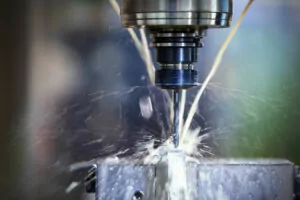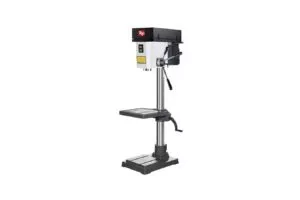Among the most versatile tools in any modern manufacturing facility or workshop is the vertical milling machine. At Rongfu, we understand that selecting the right equipment can significantly impact your production capabilities, operating costs, and ultimately, your bottom line.
This comprehensive guide will walk you through everything you need to know about vertical milling machines—from basic components and operation principles to selection criteria and maintenance best practices. Whether you’re considering your first mill purchase or looking to upgrade existing equipment, this resource will help you make informed decisions.
What Is a Vertical Milling Machine?
A vertical milling machine is a precision cutting tool used to remove material from workpieces through rotary cutters. What distinguishes a vertical mill from other machining equipment is the orientation of its primary cutting tool—the spindle axis is aligned vertically, perpendicular to the worktable.
The history of milling machines dates back to the early 19th century, with the first true milling machine credited to Eli Whitney around 1818. However, vertical milling as we know it today truly began taking shape in the 1860s. The fundamental design has remained consistent even as technology has evolved tremendously from fully manual machines to today’s computer numerical control (CNC) systems.
Unlike horizontal milling machines, where the spindle axis runs parallel to the worktable, vertical mills offer several distinct advantages:
- Better visibility of the cutting operation
- Easier setup and workpiece loading
- More intuitive operation for new machinists
- Generally smaller footprint in the workshop
Today’s vertical mills range from small benchtop models suitable for hobbyists to massive production machines capable of creating components for aerospace applications with micron-level precision.
How a Vertical Mill Works: Key Components
Understanding the core components of a vertical milling machine is essential for both operation and maintenance. Let’s examine the key elements that make up these versatile tools:
The Spindle Assembly
The heart of any vertical mill is its spindle—the rotating component that holds and drives the cutting tools. Key aspects include:
- Motor and Drive System: Converts electrical energy into rotational force
- Spindle Nose: Interface for tool holders (often R8, ISO, BT, CAT, or HSK taper)
- Speed Control: Allows adjustment of rotational speed (RPM) to suit different materials and operations
- Bearings: Precision components that support the spindle while allowing smooth rotation
The Work Table System
The table is where workpieces are mounted and moved during machining operations:
- Table Surface: Typically made of cast iron with T-slots for clamping fixtures
- X-Axis Movement: Horizontal movement (left to right)
- Y-Axis Movement: Horizontal movement (front to back)
- Ways: Precision-ground surfaces that guide table movement
- Feed Screws/Ballscrews: Convert rotational motion to linear movement
The Column and Head
These structural components provide rigidity and positioning capability:
- Column: The main vertical support structure of the machine
- Head: Houses the spindle and can often be adjusted (tilted) on some machines
- Z-Axis Movement: Vertical movement of either the head or the table depending on design
- Quill: On bridgeport-style machines, allows for fine vertical tool movement
Control Systems
Depending on the machine’s age and type, control systems vary significantly:
- Manual Controls: Handwheels and levers for direct operator control
- Digital Readout (DRO): Electronic position display but manual control
- CNC Control: Fully programmable operation via computer interface
Cutting Tools
Vertical mills use a wide variety of cutting tools including:
- End mills
- Face mills
- Drills
- Boring heads
- Reamers
- Taps
The versatility of tooling options makes vertical mills incredibly flexible for different manufacturing needs.
Types of Vertical Milling Machines
Vertical milling machines come in several distinct configurations, each designed for specific applications and work environments:
Manual vs. CNC Vertical Mills
| Feature | Manual Vertical Mill | CNC Vertical Mill |
| Control Method | Hand wheels, levers | Computer programming |
| Learning Curve | Moderate | Steep (programming) |
| Repeatability | Operator-dependent | Highly consistent |
| Production Volume | Low to medium | Medium to high |
| Initial Cost | $3,000-$15,000 | $10,000-$100,000+ |
| Ideal Use Case | Repair shops, one-offs | Production runs, complex parts |
Size Classifications
Benchtop/Mini Mills
These compact units are designed for small workshops, educational settings, or hobbyists:
- Typically under 500 lbs
- Limited work envelope (usually under 12″ x 6″ x 6″)
- Lower power (½ to 1½ HP motors)
- Ideal for small parts and non-production work
Knee Mills
The classic “Bridgeport-style” mill found in countless machine shops:
- 1,500-3,000 lbs typically
- Medium work envelope (often around 30″ x 12″ x 16″)
- 2-5 HP motors common
- Versatile for both one-off and small production runs
Bed Mills
Designed for heavier-duty work with greater rigidity:
- 3,000-10,000+ lbs
- Larger work envelope
- More powerful motors (5-15+ HP)
- Better suited for production environments
Machining Centers
The most advanced form of vertical mills:
- Fully enclosed
- Automatic tool changers
- Multiple axes (often 4 or 5-axis capability)
- Built for high-volume production
Each type offers distinct advantages depending on your specific needs, available space, and budget constraints.
Top Uses & Applications
Vertical milling machines are workhorses across numerous industries and applications:
Metalworking Industries
- Automotive: Engine components, transmission parts, custom fixtures
- Aerospace: Lightweight structural components, instrument panels, testing fixtures
- General Manufacturing: Molds, dies, jigs, and fixtures
- Defense: Precision components for weapons systems and vehicles
Material Compatibility
Vertical mills can work with a wide range of materials, though tooling and operating parameters must be adjusted accordingly:
- Metals: Aluminum, brass, steel, stainless steel, titanium
- Plastics: Acrylic, nylon, delrin, UHMW
- Composites: Carbon fiber, fiberglass
- Wood: Hardwoods, softwoods, MDF
Common Operations
- Facing: Creating flat surfaces
- Profiling: Cutting complex external shapes
- Pocketing: Creating recesses or cavities
- Drilling: Creating precise holes
- Boring: Enlarging and finishing holes
- Thread Milling: Creating internal or external threads
This versatility makes vertical milling machines essential equipment for any facility engaged in precision manufacturing or prototyping work.
Buying Guide: How to Choose the Best Vertical Mill
Selecting the right vertical milling machine requires careful consideration of several factors. Here’s what experienced manufacturing managers should evaluate:
Assessing Your Requirements
Start by thoroughly analyzing your specific needs:
- Part Size: What are the maximum dimensions of parts you’ll machine?
- Materials: What materials will you commonly work with?
- Tolerances: What level of precision is required?
- Production Volume: One-offs, small batches, or high-volume production?
- Available Space: What are your facility’s spatial constraints?
Key Technical Specifications
Once you understand your requirements, focus on these critical specifications:
Worktable Size and Travel
- Table dimensions should exceed your typical workpiece size
- X, Y, and Z-axis travel determines the maximum machinable area
- Consider clearance between spindle and table at maximum Z-height
Spindle Specifications
- Horsepower: Higher HP enables faster cutting, especially in tough materials
- Speed Range: Wider range allows optimization for different materials and operations
- Taper Type: Common options include R8, ISO40, BT40, CAT40
- Torque: Critical for larger cutting tools and tougher materials
Machine Construction
- Weight: Heavier machines generally provide better stability and rigidity
- Materials: Cast iron components offer superior vibration dampening
- Ways: Hardened ways with turcite linings provide longer service life
- Guarding: Adequate chip and coolant containment
Control Options
- Manual Controls: Simpler but operator-dependent
- DRO (Digital Readout): Improves accuracy while remaining cost-effective
- CNC Control: Consider interface type, programming language, and features
Operating a Vertical Mill Safely
Safety should always be the top priority when operating any machine tool. Here’s a concise guide to safe vertical mill operation:
Before Operation
- Personal Protective Equipment (PPE):
- Safety glasses or face shield
- Hearing protection
- Closed-toe shoes
- No loose clothing, jewelry, or gloves that could be caught
- Long hair must be secured
- Machine Inspection:
- Check for damaged components or loose parts
- Ensure guards are in place and functioning
- Verify cutting tool is properly secured
- Confirm workpiece is properly clamped
- Setup Verification:
- Double-check all dimensions and offsets
- Verify speeds and feeds are appropriate for material
- Ensure coolant levels are adequate if used
During Operation
- Never leave a running machine unattended
- Stay alert and focused on the operation
- Keep hands away from rotating cutters
- Use a brush, never hands, to clear chips
- Stop the machine immediately if abnormal sounds occur
After Operation
- Allow spindle to stop completely before changing tools
- Clean machine thoroughly after use
- Return tools to proper storage
- Document any issues or concerns
By following these safety protocols, you’ll minimize risk while maximizing productivity and equipment lifespan.
Maintenance & Troubleshooting
Proper maintenance is crucial for ensuring accuracy, reliability, and longevity of your vertical milling machine.
Preventive Maintenance Schedule
| Frequency | Action Items |
| Daily | • Clean chips and debris • Check coolant level and concentration • Inspect cutting tools for wear • Verify lubrication points |
| Weekly | • Clean and lubricate way surfaces • Check drive belts for tension • Clean filters • Inspect electrical connections |
| Monthly | • Check ballscrew backlash • Inspect for hydraulic/pneumatic leaks • Verify alignment • Test emergency stop functions |
| Quarterly | • Lubricate bearings • Check spindle runout • Inspect coolant pump • Verify accuracy with test cuts |
| Annually | • Complete alignment check • Professional service inspection • Electrical system testing • Complete mechanical overhaul if needed |
Common Issues and Solutions
Chatter
- Causes: Improper speeds/feeds, inadequate workpiece support, dull tooling
- Solutions: Adjust cutting parameters, improve workholding, replace cutting tools
Poor Surface Finish
- Causes: Dull tools, excessive cutting speed, improper feed rate
- Solutions: Replace or sharpen tools, adjust cutting parameters
Inaccurate Dimensions
- Causes: Backlash, worn gibs, temperature fluctuations
- Solutions: Adjust backlash compensation, tighten gibs, ensure consistent temperature
Spindle Issues
- Causes: Worn bearings, inadequate lubrication, contamination
- Solutions: Replace bearings, ensure proper lubrication, improve sealing
Implementing a rigorous maintenance program will substantially reduce downtime and extend the useful life of your equipment while maintaining precision.
Vertical Milling vs Horizontal Milling
Understanding the differences between vertical and horizontal milling helps in selecting the right machine for specific applications:
| Feature | Vertical Milling | Horizontal Milling |
| Spindle Orientation | Perpendicular to worktable | Parallel to worktable |
| Visibility | Excellent visibility of cutting operation | Limited visibility during operation |
| Typical Applications | Facing, pocketing, profiling, drilling | Side milling, slotting, straddle milling |
| Tool Support | Single-end support of cutting tools | Arbor supports both ends of cutting tools |
| Rigidity | Good for most operations | Superior for heavy cutting operations |
| Space Requirements | Generally smaller footprint | Typically requires more floor space |
| Learning Curve | More intuitive for beginners | Steeper learning curve |
| Versatility | Excellent for varied one-off work | Better for production runs |
Many shops benefit from having both types available, using each for its strengths. If you can only have one machine type, a vertical mill offers greater versatility for most general machining operations. For specialized production work, particularly with heavy material removal, horizontal mills often prove more efficient.
For more specific guidance on whether a vertical mill or drill machine would better suit your needs, contact our applications specialists.
Frequently Asked Questions
What’s the difference between a vertical mill and a drill press?
What spindle speeds do I need for different materials?
Aluminum: 1,000-10,000 RPM
Mild Steel: 500-1,000 RPM
Stainless Steel: 300-800 RPM
Plastics: 1,500-3,000 RPM
How do I determine the right feed rate?
What is the difference between manual and CNC vertical mills?
How much should I budget for a good vertical milling machine?
What are the most important accessories for a vertical mill?
- Digital readout (DRO)
- Quality vise
- Clamping kit
- Collet set
- End mill assortment
- Edge finder
- Dial indicator
Can vertical mills cut hardened steel?
How long does it take to learn to operate a vertical mill?
Conclusion & Next Steps
Vertical milling machines represent one of the most versatile and valuable investments for any manufacturing operation. From simple manual mills to sophisticated CNC machining centers, these tools enable precision manufacturing across countless industries and applications.
At Rongfu, we’re committed to helping you find the perfect vertical milling solution for your specific needs. Our experts can guide you through the selection process, ensuring you choose a machine that balances performance, reliability, and value.
We invite you to explore our complete range of vertical milling machines and contact our team to discuss your specific requirements. Whether you’re expanding your capabilities or replacing aging equipment, we’re here to support your manufacturing success.
For more information or to schedule a demonstration, contact our sales team today.





